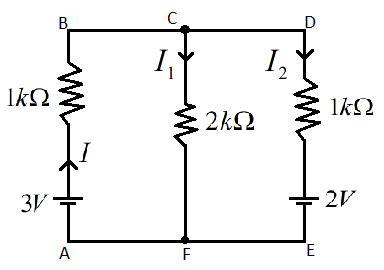
Calculate the potential difference across the \[2k\Omega \] resistor in the circuit shown in figure. The internal resistance of the cells are negligible


Answer
569.1k+ views
Hint: We are given a circuit diagram with three resistors and two cells. Since the internal resistances of the cells are negligible we don’t need to consider them. By applying Kirchhoff’s loop rule and junction rule we will get two equations. By equating them we will obtain the current passing through each resistor. Using ohm’s law we will get the potential difference through the resistor.
Formula used:
Junction Rule, ${{I}_{in}}={{I}_{out}}$
Loop rule, $\sum{V}=0$
$V=IR$
Complete answer:
Consider the figure given below.

Let ‘$I$’ be the current flowing from the ‘$3V$’ battery.
We know that at the junction ‘C’ this current will split.
Therefore the current passing through the resistance $2k\Omega $ will be ‘${{I}_{1}}$’ and through the resistance $1k\Omega $ will be ‘${{I}_{2}}$ .
Then we know that according to Kirchhoff’s junction rule,
$I={{I}_{1}}+{{I}_{2}}$
Now let us consider the loop ABCFA in the given figure.
By applying Kirchhoff’s loop rule we will get,
$3-I-2{{I}_{1}}=0$
Since $I={{I}_{1}}+{{I}_{2}}$, we can write the above equation a,
\[\Rightarrow 3-\left( {{I}_{1}}+{{I}_{2}} \right)-2{{I}_{1}}=0\]
\[\Rightarrow 3-{{I}_{1}}-{{I}_{2}}-2{{I}_{1}}=0\]
By simplifying this we will get our first equation as,
\[\Rightarrow 3=3{{I}_{1}}+{{I}_{2}}\]
Let the above equation be the first equation.
Now let us consider the loop FCDEF in the given figure.
By applying Kirchhoff’s loop rule again, we will get
$2{{I}_{1}}-{{I}_{2}}-2=0$
By solving this we will get our second equation as,
$\Rightarrow 2=2{{I}_{1}}-{{I}_{2}}$
Now we have our first and second equation as,
\[3=3{{I}_{1}}+{{I}_{2}}\] and
$2=2{{I}_{1}}-{{I}_{2}}$
By comparing these two equations and adding them together, we get
$\Rightarrow 3{{I}_{1}}+{{I}_{2}}+2{{I}_{1}}-{{I}_{2}}=5$
$\Rightarrow 3{{I}_{1}}+2{{I}_{1}}=5$
$\Rightarrow 5{{I}_{1}}=5$
$\Rightarrow {{I}_{1}}=\dfrac{5}{5}=1mA$
Therefore the current passing through $2k\Omega $ resistor is $1mA$.
We need to find the potential difference across $2k\Omega $.
We know that by ohm’s law,
$V=IR$
Therefore the potential across $2k\Omega $ will be,
$\Rightarrow V=1mA\times 2k\Omega $
$\Rightarrow V=2V$
Hence the potential difference across $2k\Omega $ is $2V$.
Note:
Kirchhoff’s first rule is the junction rule. According to this rule the sum of all currents entering a junction will be always equal to the sum of all currents leaving the junction.
The second rule or the loop rule states that the sum of all the electric potential differences around a closed circuit or a loop is always zero.
Formula used:
Junction Rule, ${{I}_{in}}={{I}_{out}}$
Loop rule, $\sum{V}=0$
$V=IR$
Complete answer:
Consider the figure given below.

Let ‘$I$’ be the current flowing from the ‘$3V$’ battery.
We know that at the junction ‘C’ this current will split.
Therefore the current passing through the resistance $2k\Omega $ will be ‘${{I}_{1}}$’ and through the resistance $1k\Omega $ will be ‘${{I}_{2}}$ .
Then we know that according to Kirchhoff’s junction rule,
$I={{I}_{1}}+{{I}_{2}}$
Now let us consider the loop ABCFA in the given figure.
By applying Kirchhoff’s loop rule we will get,
$3-I-2{{I}_{1}}=0$
Since $I={{I}_{1}}+{{I}_{2}}$, we can write the above equation a,
\[\Rightarrow 3-\left( {{I}_{1}}+{{I}_{2}} \right)-2{{I}_{1}}=0\]
\[\Rightarrow 3-{{I}_{1}}-{{I}_{2}}-2{{I}_{1}}=0\]
By simplifying this we will get our first equation as,
\[\Rightarrow 3=3{{I}_{1}}+{{I}_{2}}\]
Let the above equation be the first equation.
Now let us consider the loop FCDEF in the given figure.
By applying Kirchhoff’s loop rule again, we will get
$2{{I}_{1}}-{{I}_{2}}-2=0$
By solving this we will get our second equation as,
$\Rightarrow 2=2{{I}_{1}}-{{I}_{2}}$
Now we have our first and second equation as,
\[3=3{{I}_{1}}+{{I}_{2}}\] and
$2=2{{I}_{1}}-{{I}_{2}}$
By comparing these two equations and adding them together, we get
$\Rightarrow 3{{I}_{1}}+{{I}_{2}}+2{{I}_{1}}-{{I}_{2}}=5$
$\Rightarrow 3{{I}_{1}}+2{{I}_{1}}=5$
$\Rightarrow 5{{I}_{1}}=5$
$\Rightarrow {{I}_{1}}=\dfrac{5}{5}=1mA$
Therefore the current passing through $2k\Omega $ resistor is $1mA$.
We need to find the potential difference across $2k\Omega $.
We know that by ohm’s law,
$V=IR$
Therefore the potential across $2k\Omega $ will be,
$\Rightarrow V=1mA\times 2k\Omega $
$\Rightarrow V=2V$
Hence the potential difference across $2k\Omega $ is $2V$.
Note:
Kirchhoff’s first rule is the junction rule. According to this rule the sum of all currents entering a junction will be always equal to the sum of all currents leaving the junction.
The second rule or the loop rule states that the sum of all the electric potential differences around a closed circuit or a loop is always zero.
Recently Updated Pages
A man running at a speed 5 ms is viewed in the side class 12 physics CBSE

The number of solutions in x in 02pi for which sqrt class 12 maths CBSE

State and explain Hardy Weinbergs Principle class 12 biology CBSE

Write any two methods of preparation of phenol Give class 12 chemistry CBSE

Which of the following statements is wrong a Amnion class 12 biology CBSE

Differentiate between action potential and resting class 12 biology CBSE

Trending doubts
What are the major means of transport Explain each class 12 social science CBSE

Which are the Top 10 Largest Countries of the World?

Draw a labelled sketch of the human eye class 12 physics CBSE

Explain sex determination in humans with line diag class 12 biology CBSE

Explain sex determination in humans with the help of class 12 biology CBSE

Differentiate between homogeneous and heterogeneous class 12 chemistry CBSE




